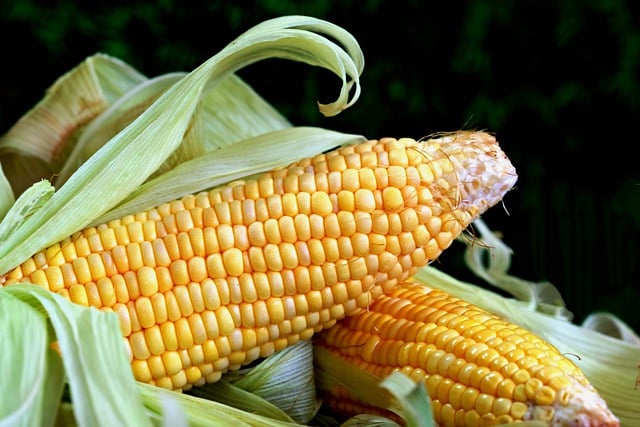Growing corn is a rewarding endeavor that can transform your backyard into a productive oasis. Whether you’re aiming to cultivate corn from seed or just want to enjoy fresh corn on the cob, this comprehensive guide will walk you through the entire process. From understanding the basics to optimizing your garden space, here’s everything you need to know about growing corn at home.

Understanding Corn Varieties
Before diving into the planting process, it’s crucial to choose the right variety of corn. The three main types of corn are sweet corn, field corn, and popcorn.
1. Sweet Corn: Known for its high sugar content, sweet corn is the type most commonly consumed fresh. Varieties include:
– Yellow Sweet Corn: Popular for its bright yellow kernels.
– White Sweet Corn: Known for its tender and sweet white kernels.
– Bicolor Sweet Corn: A mix of yellow and white kernels, offering a sweet and visually appealing option.
2. Field Corn: Mainly used for animal feed, cornmeal, and other industrial purposes. It’s not typically grown for fresh eating due to its tough texture and lower sugar content.
3. Popcorn: A fun variety to grow that produces small kernels that pop when heated. It’s slightly more challenging to grow but can be a unique addition to your garden.
Preparing Your Garden
Location and Soil
Corn requires full sun, so choose a location that receives at least 6-8 hours of direct sunlight daily. The soil should be well-drained, fertile, and rich in organic matter. Corn thrives in slightly acidic to neutral soil with a pH between 6.0 and 6.8.

Soil Preparation
1. Testing Soil: Conduct a soil test to determine the pH and nutrient levels. Amend the soil based on the test results.
2. Tilling: Loosen the soil to a depth of 8-10 inches using a tiller or garden fork.
3. Adding Compost: Incorporate compost or well-rotted manure to enrich the soil with organic matter.
How to Plant Corn Seeds
Seed Selection
Purchase high-quality corn seeds from a reputable supplier. Ensure the seeds are treated to protect them from soil-borne diseases.
Sowing Seeds
1. Timing: Plant corn seeds after the last frost date in your area when the soil temperature is at least 60°F (16°C).
2. Spacing: Sow seeds 1-2 inches deep and 8-12 inches apart. Plant in blocks of at least four rows to ensure proper pollination. Space the rows 30-36 inches apart.
Germination
Corn seeds typically germinate in 7-10 days under optimal conditions. Maintain consistent soil moisture during this period.

How to Care for Corn Plants
Watering
Corn has shallow roots and requires regular watering. Provide 1-1.5 inches of water per week, ensuring the soil remains consistently moist but not waterlogged. Deep watering encourages strong root development.
Fertilization
Corn is a heavy feeder and benefits from regular fertilization. Apply a balanced fertilizer (such as 10-10-10) at planting time and side-dress with nitrogen-rich fertilizer when plants are 12 inches tall and again when tassels appear.
Mulching
Mulch around the base of the plants with straw or grass clippings to conserve moisture, suppress weeds, and regulate soil temperature.
Pollination
Corn is wind-pollinated, meaning it relies on the wind to carry pollen from the tassels to the silks. Proper pollination is crucial for kernel development.
Enhancing Pollination
To improve pollination:
– Plant corn in blocks rather than single rows.
– Gently shake the stalks when tassels appear to help distribute pollen.
Managing Pests and Diseases
Common Pests
1. Corn Earworms: These pests burrow into the ears and feed on the kernels. Use insecticidal sprays or apply mineral oil to the silks to deter them.
2. European Corn Borers: These caterpillars bore into the stalks and ears, causing significant damage. Control them with Bacillus thuringiensis (Bt) or insecticidal sprays.
3. Aphids: These small insects suck sap from the plants, causing stunted growth. Use insecticidal soap or neem oil to manage aphid infestations.
Common Diseases
1. Common Rust: This fungal disease causes reddish-brown pustules on the leaves. Control it by planting resistant varieties and applying fungicides if necessary.
2. Corn Smut: This fungal disease forms large, grayish galls on the ears and stalks. Remove and destroy infected plants to prevent the spread of the disease.
3. Leaf Blight: This disease causes elongated lesions on the leaves. Manage it by rotating crops and applying fungicides.
Harvesting Corn
When to Harvest
Sweet corn is typically ready for harvest 60-100 days after planting, depending on the variety. The ears are ready when the silks turn brown, and the kernels are plump and milky.
How to Harvest
To harvest corn:
1. Inspect Ears: Check for mature ears with brown silks and full kernels.
2. Harvest: Hold the ear firmly, twist, and pull downward to remove it from the stalk.
Post-Harvest Handling
Immediately after harvesting, consume or refrigerate sweet corn to maintain its sugar content and flavor. Corn can also be blanched and frozen for later use.
Growing Corn at Home: Special Considerations
Container Gardening
While corn is traditionally grown in the ground, it can also be grown in large containers. Use a container with a capacity of at least 20 gallons, and plant dwarf varieties suited for smaller spaces.
Vertical Gardening
If you have limited space, consider vertical gardening techniques. Train corn stalks to grow against a trellis or support structure. This method works best with smaller, dwarf varieties.
Companion Planting
Corn benefits from companion planting. Plant beans and squash alongside corn. Beans fix nitrogen in the soil, benefiting corn, while squash acts as a natural mulch, suppressing weeds and conserving moisture.
Troubleshooting Common Issues
Poor Germination
Ensure soil temperature is warm enough and maintain consistent moisture. Avoid planting too early when the soil is still cool.
Weak Stalks
Provide adequate spacing to prevent overcrowding. Stake tall varieties to support the stalks and protect them from wind damage.
Uneven Kernel Development
Enhance pollination by planting in blocks and shaking the tassels. Ensure the soil has sufficient nutrients, particularly nitrogen, to support kernel development.
Conclusion
Growing corn at home is a fulfilling experience that allows you to enjoy fresh, sweet corn on the cob straight from your backyard. By following these guidelines on planting, caring, and harvesting, you can cultivate a bountiful crop of corn. With proper preparation and attention to detail, you’ll be well on your way to reaping the rewards of your homegrown corn. Happy gardening!

